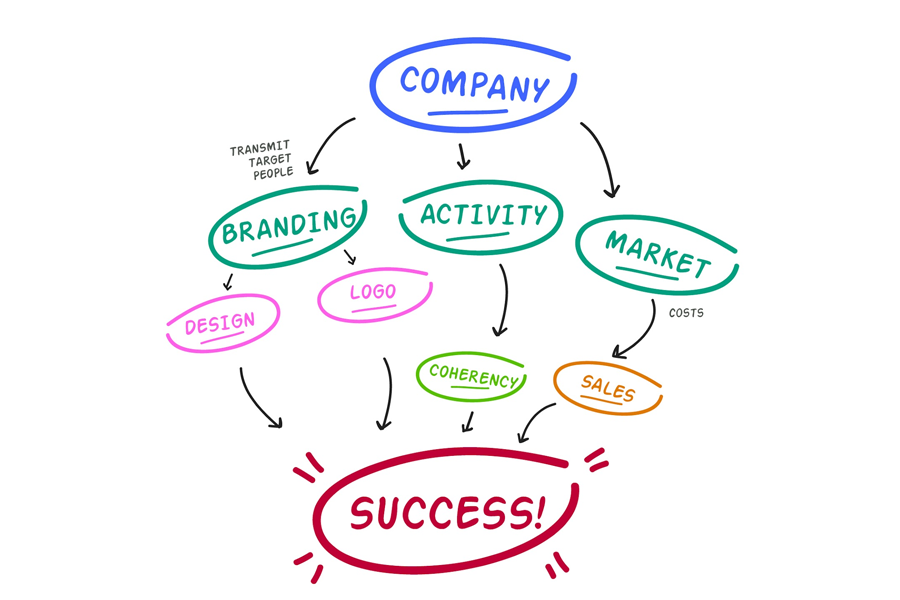
Sometimes, when you brainstorm ideas, it tends to get really messy and cluttered – as if all your ideas are scattered and not organized. This is where the mind map comes in.
The mind map is a diagram for representing words, tasks, concepts, or items arranged and linked around a central idea or concept using a non-linear mapping. It allows your brainstorming and knowledge visualization to come in an intuitive framework.
Mind maps can turn a long list of monotonous information into a vibrant, creative, and highly organized diagram that emerges from your brain. This, in return, can help you more in planning and concept mapping with your organization or company.
In this article, you will learn what are the best mind mapping tools to use for your personal planning and for your business or company.
Let’s get started!

What are Mind Mapping Tools: The Basics
Mind mapping tools allow users to organize their visual thinking into a diagrammatic representation. It allows you to visually organize and structure thoughts, ideas, and information into a visual representation in the form of a map or diagram, stitching related ideas and concepts.
At their core, mind mapping tools or software applications are designed to mimic the way our brains naturally organize and arrange information, through hierarchies, associations, and connections.
For example, imagine a blank paper or canvas where you write down ideas freely, connect them with lines, and arrange them as your thoughts evolve. That is exactly how mind-mapping tools work. They provide a platform for brainstorming sessions, concept-mapping exercises, and knowledge visualization tasks.
Mind maps usually fall under four categories:
- Brainstorming: Organizing ideas visually with problem-solving sessions;
- Diagramming: Technical diagrams for architectural designs, engineering flowcharts, network diagrams, and others;
- Business intelligence: Visualizing data as charts from business applications;
- Software development project management: Software wireframes, etc.
In the heart of your mind map lies the hierarchical structure. You can start with a central topic or idea, represented as a node (a point in the mind map that shows some ideas of information), and branch outwards to navigate related subtopics or concepts.
Each branch represents various aspects of the central topic, creating a visual hierarchy that mimics the natural flow of thoughts in your mind.
Branches and nodes can be customized with icons, text, and colors, allowing you to add context to the meaning of your ideas. This feature on mind mapping software makes the mind map engaging and helps users to grasp the relationships between one element to another by using color segmentation.
Benefits of Planning with Mind Maps
Planning helps for successful project management and business operations.
Using mind-mapping tools in this process can give you multiple benefits like:
- Improved communications: Mind maps act like a visual communication tool that makes it easier for team members to comprehend complex project structures and dependencies. Visual representations enhance clarity and promote effective communication among your team members whether it is discussing resource allocations, project milestones, task assignments, etc.
- Enhanced creativity: Project planning involves brainstorming of ideas and identifying creative solutions and challenges. What mind mapping tools do is stimulate creative thinking by giving a flexible platform for idea generation. The non-linear nature of mind maps allows out-of-the-box thinking that leads to the development of innovative solutions and approaches.
- Focus and clarity: By visually organizing tasks, project goals, and timelines, mind maps give a clear overview of the project scope and objectives. The clarity and focus mind map helps team members to stay aligned with their responsibilities and roles, effectively reducing the risk of miscommunications and confusion.
- Efficient budget and resource allocation: Effective project planning requires a careful and efficient allocation of resources like budget, time, and manpower. Mind maps help project managers visualize resource requirements and constraints, enabling them to make sound decisions about the optimization and distribution of resources.
- Risk mitigation: Mind maps also facilitate the identification of potential risks and obstacles through the project planning cycle.
- Increased productivity: By streamlining the project planning process and leveraging a visual roadmap for project execution, mind mapping tools enhance overall productivity.
- Flexibility and adaptability: Projects are done over time, requiring teams to adapt to changing requirements and other circumstances. Mind mapping tools allow you to be flexible, making your project planning easily modified and updated as needed.
Lastly, mind mapping can also help you with the alignment of stakeholders’ expectations by providing a visual representation of project goals and objectives.
Essential Features of Mind Mapping Software
When considering mind mapping tools for planning and organization, it’s important to understand the essential software features that help the tool to be effective. These features can help you create, manage, and collaborate on mind maps seamlessly, enhancing productivity and creativity.
Here are some of the most useful features you need to look for:
- Cross-linking: This feature allows you to make connections between branches and nodes within the mind map. This feature facilitates the visualization of dependencies and relationships, making you explore complex concepts and ideas more efficiently and effectively.
- Intuitive interface: A mind mapping tool must have a user-friendly interface so that you can easily navigate and familiarize with it. Intuitive controls include drag-and-drop functionality alongside customizable layouts for a seamless user experience.
- Hierarchical organization: A mind mapping tool should support hierarchical structure or organization. It allows you to create parent-child-like relationships with nodes.
- Collaborative capabilities: Collaboration is very important for team-based project planning. Find mind-mapping tools that offer a real-time collaboration feature that allows you multiple users to work on the same map simultaneously and seamlessly. It should have a feature of commenting, editing, and sharing to streamline communication and teamwork.
- Visual customization: Color coding icons and formatting tools enable you to personalize your mind map to convey ideas or information more effectively.
- Integration with project management software: If the mind mapping tool is seamlessly compatible with project management software, you can guarantee that you can sync tasks, deadlines, and other project details with your mind map.
- Version history: Version history with the undo and redo feature is really essential so that you can track changes in the mind map if ever you are working with collaborators or just plainly wanting to see your previous changes. Undo and redo are crucial so that you can mitigate accidental modifications, etc.
- Export and import option: A great mind mapping tool should be able to support different kinds of file formats for exporting and importing maps. This feature allows you to be able to share your mind map seamlessly for presentation or turning them into documents.
- Security and data privacy: Data security is and will never be neglected. It should be a paramount feature especially if you are dealing with highly sensitive project information. Choose a mind-mapping software that prioritizes security features like encryption, access controls, and cloud storage.
By considering these essential software features, you will be able to select the right mind-mapping tool that best suits your project planning or other organizational needs.
Mind Mapping Tool Comparison
To further help you, here are some of the best mind-mapping tools for 2024 and their features, pros, cons, and pricing.
XMind
X mind is a simple and easy-to-use mind-mapping software that also helps generate tasks, ideas, and goals.
This tool’s capabilities extend beyond mind mapping. Иt also offers various information views, like an outliner for those who prefer a linear format for their mind map, a pitch mode for presenting ideas, and a zen mode for a distraction-free environment.
| XMind | |||
| Feature | Pros | Cons | Pricing |
| Brainstorming templates and multi-branch colors to identify various nodes, equation features, etc. | Has passwords for your mind map files, mind maps can be exported via PNG, PDF, or markdowns, app is available for mobile devices. | No free plan, large mind maps take too much time to load | 39.99 USD or 647,198.16 IDR / six months |
Coggle
Coggle is an online tool with mind mapping and flowchart features, best to use for processes, algorithms, and systems.
It allows users to work with multiple people on one diagram, and it can be utilized in any grade level or subject.
| Coggle | |||
| Feature | Pros | Cons | Pricing |
| Drag-and-drop features, floating texts and images, joint branches and loops to represent different processes, etc. | Real-time collaboration | No whiteboard feature, no desktop or mobile app, only online | 5 USD or 80,920 IDR / month |
ConceptDraw MINDMAP
ConceptDraw MINDMAP is an idea management and diagramming tool that helps create data visualization and helps organize your ideas using Microsoft Office.
It is a professional-grade software that generates a wide range of document styles and formats.
| ConceptDraw MINDMAP | |||
| Feature | Pros | Cons | Pricing |
| Built-in timer for brainstorm mode, hypernote feature, graphics functionality, etc. | Has 20+ mapping themes, can add attachments, can transfer mind mapping files with MS Office and other mind mapping software | No mobile device support, expensive | 199 USD or 3,223,859.70 IDR / single-user license |
MindMeister
MindMeister is a web-based mind mapping software that has a real-time collaboration feature to brainstorm ideas.
It has features beyond mind-mapping like designing timelines, creating to-do lists, project planning, etc.
| MindMeister | |||
| Feature | Pros | Cons | Pricing |
| History version, comments, and votes features for team collab, multiple themes with colors, formatting, styles, etc., and can display mind maps as a slideshow | Export mind maps in PDF, PNG, and Word formats, integrate mind maps into project management with MeisterTask | Limited features for free plans, can’t generate free-flowing maps, formatting errors for undo features | 2.49 USD or 40,338.37 IDR / month |
Miro
Miro is a free mind map software with collaboration features. It helps you create concepts, map customer stories or journeys (for business purposes), conduct roadmap planning, etc.
The tool has cross-functional team features like meetings and workshops, sharing, presentation, and others.
| Miro | |||
| Feature | Pros | Cons | Pricing |
| Supports multiple designs, built-in video and chat with mentions, pre-built templates, etc. | Infinite whiteboard for brainstorming, free-form diagrams, and integration with project management tools like Jira, Asana, and Slack | Can’t give guests editing access, paid plans are expensive, etc. | Free plan but the paid plan costs 10 USD or 162,000 IDR / month |
MindManager
MindManager is a mind mapping application best for extensive brainstorming sessions.
It has features that allow formulas and budget calculations, Gantt charts, and guided brainstorming. Your documents can be attached to the mind map and you can also enjoy many other features.
| MindManager | |||
| Feature | Pros | Cons | Pricing |
| 25+ pre-built templates for diagrams, co-editing features and real-time collaboration, etc. | Keyboard shortcuts for creating mind maps faster, allows making an org chart, flowchart, or concept map, etc. | No free plan, a limited selection of icons and images | 99 USD or 1,603,800 IDR / year |
There are many more mind mapping software solutions out there that show different features and strengths. You just need to figure out which one suits your needs and preference for your project requirements.

Project Planning with Mind Maps
Mind mapping goes beyond the traditional approach to project management by enabling a dynamic and visual framework for organizing ideas, tasks, and resources.
Here’s how project planning with mind maps elevates the planning processes:
- Mind mapping helps for organizing ideas on brainstorming sessions for project planning.
- It facilitates hierarchical organization and allows project managers to break down the project into doable tasks and subtasks.
- It enables project managers to prioritize tasks and allocate resources efficiently and effectively.
- It facilitates the pin-pointing of task dependencies and possible risks.
Mind maps have collaborative planning processes that are essential for team members to be able to contribute their ideas, give feedback, and make updates to the mind map in real time.
Collaborative Mapping
Collaborative mapping allows more than one user to edit a shared mind map in real-time. It shows a collective approach to information organization and knowledge sharing.
Mind maps enable team members to collaborate seamlessly by adding nodes, branches, and annotations to the map, enrich the content and make room for possible insights.
Through collaborative mapping, your team can use the power of information hierarchy and attain greater insights, innovation, and clarity for the projects.

Boosting Creativity and Problem-Solving
One of the core benefits of mind-mapping tools in project planning and organization is to boost the creativity and problem-solving of individuals or team members. These tools give a dynamic and visually stimulating landscape that encourages free-flowing thoughts and exploration, just like how a brain works!
By breaking away from linear or one-directional thinking and embracing non-linear mapping, teams in an organization can unleash their creativity and see challenges differently with different solutions from multiple angles.
Frequently Asked Questions
What important feature should I look for in a mind-mapping tool?
Consider features like cross-linking, real-time collaboration, hierarchical organization, integration with project management, mobile accessibility, and visual customization.
Which mind mapping tools are best for collaborative project planning?
You can start with tools like Coggle, XMind, and MindMeister.
Which mind-mapping tools are best for a single user?
You can leverage SimpleMind, Notion, XMind, MindNode, and FreeMind.